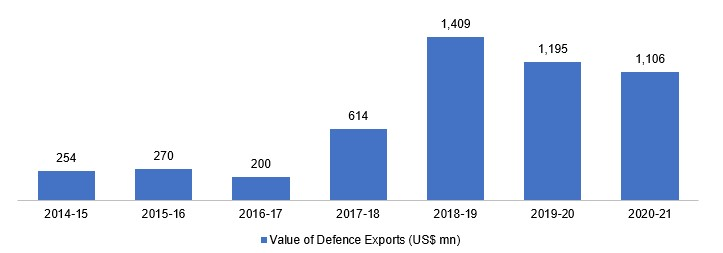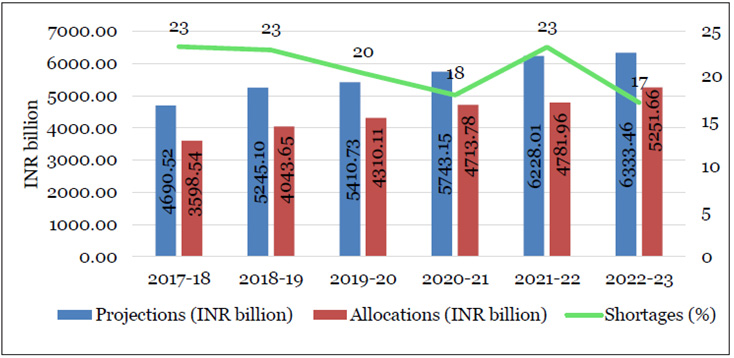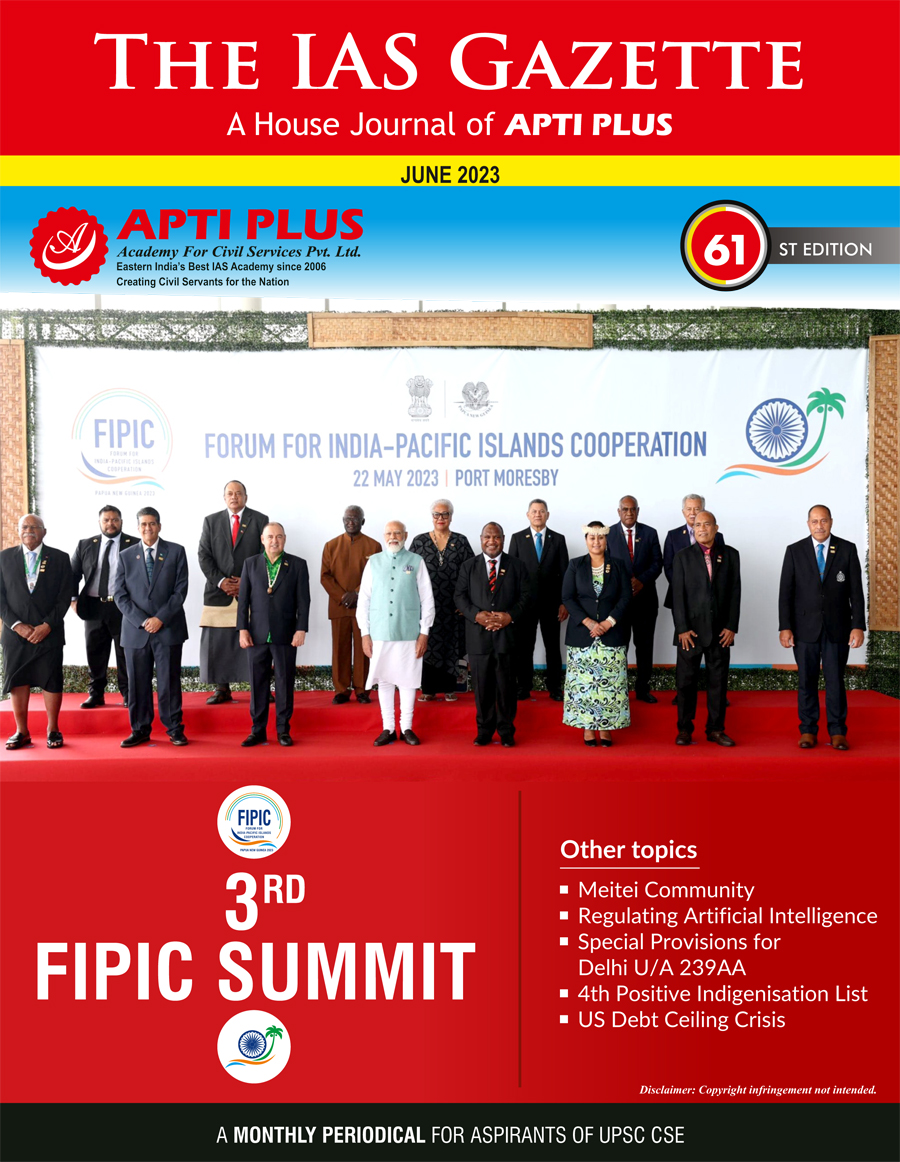SPOTLIGHT| GOVERNMENT PUSH FOR ATMANIRBHARTA IN DEFENCE
Context
- The Defence Ministry has imposed phased ban on the import of 928 military items to promote self-reliance in the defence manufacturing sector.
Details:
- The fresh list of 928 military items, including line replacement units, sub-systems and spares, which came under a phased import ban between December 2023 and December 2029.
- In statement the Ministry of Defence said that, the 928 items in the fourth list, with import substitution value of 715 crore rupees, will be procured from the Indian industry.
- It added that of the 1,238 earlier items, 310 have been indigenised so far. It covers items used in fighter planes, trainer aircraft, warships and different types of ammunition.
- The Ministry said the Defence PSUs will undertake indigenisation of 928 listed items through different routes under 'Make' category and in-house development.

About Aatmanirbhar India:
- The Atmanirbhar Bharat Abhiyaan, or Self-reliant India campaign, is a movement which was launched by the Prime Minister of India, Mr. Narendra Modi, in May 2020. Aatmanirbhar Bharat Abhiyaan aims to make the citizens of India self-reliant in all aspects.
- The Prime Minister of India outlined five major pillars of self-reliant India: economy, infrastructure, system, vibrant demography and demand.
- The government of India declared enablers and government reforms in various sectors.
- Under the Aatmanirbhar Bharat Abhiyaan, the government plans to implement various reforms to lure investors, improve ease of doing business and reinforce the Make in India initiative.
The key features of Aatmanirbhar Bharat mission’s five pillars are:
- Economy: Expand the country’s economy to US$ 5 trillion by 2025
- Infrastructure: Invest more than Rs. 10,000,000 crore (US$ 1.3 trillion) in infrastructure expansion over the next five years for achieving the US$ 5 trillion economy goal
- Systems: Implement systems based on 21st century technologies
- Vibrant Demography: Enhance India’s competitive edge for self-reliance over the next five years
- Demand: Utilise full resources and capacity.
Value of Defence Exports

About Aatmanirbharta in Defence:
- India is one of the largest arms importers in the world, accounting for 11% of the total arms sales globally.
- Enhancing the defence technology, achieving customisation and uniqueness is important for India to develop a surprise element over its nemesis.
- For encouraging industries and start-ups, research and development is crucial to achieving self-reliance in the defence sector.
- Researchers claim that self-reliance in the defence sector is the most important constituent of Aatmanirbharta. Domestic weapon production has economic, technological and philosophical linkages.
- To become a superpower in the world, Indian must achieve self-reliance in the production of defence equipment; Aatmanirbhar Bharat Abhiyan is expected to help India achieve self-reliance in defence manufacturing.

Benefits of Aatmanirbharta in Defence:
- Self-reliance in the defence industry will enhance India’s strategic independence and promote development in the country’s domestic defence and aerospace industry.
- Private sector will benefit from the transformation due to export authorisation and the embargo imposed by the government on import of various products.
- India will be able to reduce its reliance on imports by increasing domestic production.
- India will be able to boost exports and achieve its 2025 export target of Rs. 36,500 crore (US$ 4.8 billion).
READ: https://www.iasgyan.in/rstv/perspective-indias-defence-exports-17
India’s Roadmap to Self-reliance in Defence
The Make in India movement
- The Make in India movement in the defence sector will be a key towards Aatmanirbharta in Defence. India currently imports most of defence products it uses.
Private sector participation
- Private sector participation in defence will encourage foreign producers to form strategic partnerships with various Indian businesses.
Strategic collaboration
- This strategic collaboration will enhance the producers’ exposure to the unexplored defence sector of India and generate numerous opportunities for the Indian companies by strengthening production and upgrading equipment.
- Accommodative government rules will help in achieving self-reliance, besides promoting indigenisation and technology modernisation.
- The guidelines proposed by the government of India will also help attain economies of scale and improve export capabilities of the country.
Wide-ranging transformation plans
- India has wide-ranging transformation plans which are expected to expand its focus on security and help it become a defence sourcing hub.
- India’s ability to develop and sell indigenous missiles, radar systems, and other defence equipment has enabled it to become a modern defence partner to many Asian countries.
- The Make in India movement has been effective in supplying various equipment which are being extensively used by the armed forces of India.
Acceptance of Necessity
- From 2018 to 2021, the government of India granted Acceptance of Necessity to over 150 proposals worth Rs. 2,47,515 crore (US$ 32.4 billion) under various categories of capital procurement, which is expected to enhance local manufacturing as per The Defence Acquisition Procedure (DAP- 2020).
- Additionally, from 2018 to January 2022, of the total 191 capital acquisitions made, almost 121 were inked with Indian suppliers for procuring defence equipment for the armed forces.
Enhance trust
- The Make in India movement will help enhance clarity, trust, expertise, value, and consistency by opening doors to innovation, besides creating jobs and opportunities to integrate the right skills.
READ: https://www.iasgyan.in/daily-current-affairs/aatmanirbhar-in-defence-production
Challenges of Aatmanirbharta in Defence
Large import:
- The prime reason for the large import of defence equipment is the inability of our existing R&D organisations, Ord Fys and DPSUs to develop and manufacture the modern, high-tech and advanced weapon systems/platforms indigenously.
There are gaps in the capacity and capability of the DPSUs:
- The requirements of the armed forces for modernisation/ upgradation of the equipment profile, which leads to the off-the-shelf procurement of arms/weapon systems ex-import.
There is dismal participation in R&D:
- There is enormous scope for investment in defence R&D by the public as well as private sector, but, in reality, the participation by the public sector has been dismal, whereas there has been nil participation by the private sector.
Outdated structure:
- The outdated structure of defence production calls for great attention. It is felt that India has been extremely late in carrying out policy reforms in the defence sector. Momentum was gained only after the Kelkar Committee Report.
Lack of Foreign Direct Investment
- There is a lack of Foreign Direct Investment (FDI) in the defence sector. The aspect of FDI has not received adequate importance so far and, hence, there has been very low FDI in the defence sector.
Negligible private sector participation
- There is a negligible participation by the private sector. So far, the environment has not been very conducive for the active participation of the private sector in defence manufacturing. Only a few big orders have been placed on a handful of large firms.
Government Initiatives
- The government would approve at least five projects under Make-I during 2022-23 for boosting industry-backed R&D efforts.
- A mechanism under DG-Acquisition has been implemented to monitor the budget reserved, particularly for start-ups and private companies, to ensure it is entirely utilised.
- The government plans to modernise the QA procedure to ensure it is non-intrusive.
- iDEX-Prime aims to encourage projects that may necessitate support beyond Rs. 1.5 crore (US$ 0.2 million), up to Rs. 10 crore (US$ 1.3 million), to help developing start-ups in the defence sector.
- Around 68% of the capital procurement budget would be earmarked for the domestic industry.
- The industrial licensing process would be streamlined with longer authentication period.
- An indigenisation portal called SRIJAN would be launched to support indigenisation by Indian entities, including MSMEs.
- Two industrial defence corridors would be launched, one each in Uttar Pradesh and Tamil Nadu.
READ: https://media.neliti.com/media/publications/327332-an-overview-of-indian-defence-industry-a-4f293535.pdf
Road Ahead
- A robust government policy will help in achieving the objectives of the Aatmanirbhar Bharat Abhiyan.
- The Union Budget 2022–23 serves as a blueprint for enhancing and developing a vibrant ecosystem through research and development, indigenous manufacturing, modern technology, etc.
- Aatmanirbhar Bharat Abhiyan will create several opportunities for start-ups and private sector companies to showcase their domestic capabilities.
- The government’s role as a mediator will help improve the processes and boost the sector. However, it is crucial that the industry works in tandem with the government to achieve self-reliance and the US$ 5 trillion economy target.
- India is significantly realising the need for self-reliance. The country is drastically reducing its import needs and promoting domestic defence capabilities.
READ: https://www.iasgyan.in/daily-current-affairs/defence-exports
https://newsonair.gov.in/News?title=Government-bans-import-of-928-items-to-promote-domestic-defence-industry&id=460935

NEWS IN SHORT
WHOLESALE PRICE INDEX (WPI) INFLATION
Context
- The Wholesale-Price based inflation (WPI) slipped into the negative territory for the first time in almost three years, as overall prices eased across the board for the month of April this year.
Details:
- The WPI inflation fell (minus) 0.92 percent in April 2023, as compared to 1.34 percent recorded in March and 15.38 percent in April last year. The WPI inflation has fallen into negative for the first time since July 2020.
- The decline in the rate of inflation in the month of April is primarily contributed by the fall in prices of basic metals, food products, mineral oils, textiles, non-food articles, chemical and chemical products, rubber and plastic products, and paper products.
- The country’s WPI inflation has been easing continuously for the last 11 months. The month-over-month change in WPI for the month of April 2023 over March 2023 remained at 0.0 percent.
- The depreciation in WPI is in line with the decline of retail inflation in April. Retail inflation, based on the Consumer Price Index (CPI), eased to an 18-month low of 4.7 percent in April.
About WPI inflation
- The Wholesale Price Index (WPI) reflects changes in the average prices of goods at the wholesale level — that is, commodities sold in bulk and traded between businesses to other businesses or entities rather than goods bought by consumers.
- Thus, WPI is the price that wholesalers (factories) pay. A rise in the index means that factories have to pay more for raw materials.
Published by
- WPI is released by the Economic Advisor in the Ministry of Commerce and Industry.
- The index basket of WPI categorises commodities under three groups — primary articles, fuel and power-manufactured products.
Major components
- Primary articles are a major component of WPI, further subdivided into Food Articles and Non-Food Articles.
- Food Articles include items such as Cereals, Paddy, Wheat, Pulses, Vegetables, Fruits, Milk, Eggs, Meat & Fish, etc.
- Non-Food Articles include Oil Seeds, Minerals and Crude Petroleum.
READ: https://www.iasgyan.in/daily-current-affairs/wholesale-inflation
https://newsonair.gov.in/News?title=WPI-slips-into-negative-territory-for-the-first-time-in-three-years%2c-falls--0.92%25-in-April&id=460955

50 START-UPS EXCHANGE PROGRAMME
Context
- The first group of 10 start-up companies under the 50 start-ups exchange programme between India and Bangladesh returned to Dhaka after completing a successful five-day visit to India from 8-12 May.
Details:
- Under this programme, 50 Start-ups from Bangladesh and 50 Start-ups from India will exchange visits to each other’s countries for exploring partnerships, expanding business relations, sharing experience and knowledge and expanding youth and entrepreneurial cooperation.
- The framework of the programme was decided by the Prime Ministers of the two countries during their recent bilateral summits.
- These Start-ups belong to sectors such as e-commerce, health, transport and logistics, energy, education and skill development.
Objective:
- The objective of the program is to strengthen bilateral relations between India and Bangladesh by promoting cooperation in start-up and innovation sectors.
Significance
- It provides a platform for entrepreneurs, investors and stakeholdersfrom both the countries to connect and collaborate.
- The '50 Start-up Exchange Program' facilitates knowledge sharing and learning opportunities between Indian and Bangladeshi start-ups.
- The potential for the Bangladeshi Start-ups to tap into the Indian markets, especially in the North-Eastern states of India.
- It encourages exchange of ideas, best practices and expertise to foster innovation and growth.
- The program provides mentorship and guidance to participating start-ups, connecting them with experienced entrepreneurs, industry experts and investors.
- The start-up community in both India and Bangladesh had the opportunity to enhance cooperation as the two countries explored ways to further enhance ease of doing business, including trade settlement in local currencies and collaboration in digital payment platforms.
READ: https://www.iasgyan.in/daily-current-affairs/india-bangladesh-relations-3
https://newsonair.gov.in/News?title=India-%26-Bangladesh-launch-%26%2339%3b50-Start-ups-Exchange-Programme%26%2339%3b&id=460985
SMALL MODULAR REACTORS
Context
- G-20 Sherpa Amitabh Kant addresses International Seminar titled, ‘Small Modular Reactors for Clean Energy Transition’.
Detail
- The 3rd Energy Transitions Working Group Meeting (ETWG) under India’s G20 Presidency is underway in Mumbai.
- The six priority areas, outlined under India’s G20 Presidency, include:
- Energy transition through addressing technology gaps,
- Low-cost financing for energy transition,
- Energy security and diversified supply chains,
- Energy efficiency industrial low carbon transitions and responsible consumption,
- Fuels for Future and Universal access to clean energy and
- Just, affordable, and inclusive energy transition pathway.
About Small modular reactors (SMRs)
- Small modular reactors (SMRs) are advanced nuclear reactors that have a power capacity of up to 300 MW(e) per unit, which is about one-third of the generating capacity of traditional nuclear power reactors.
- SMRs, which can produce a large amount of low-carbon electricity, are:
- Small – physically a fraction of the size of a conventional nuclear power reactor.
- Modular – making it possible for systems and components to be factory-assembled and transported as a unit to a location for installation.
- Reactors – harnessing nuclear fission to generate heat to produce energy.
Advantages of SMRs
- Small Modular Reactors present numerous advantages, such as the reduction of costs and construction time.
- Power flexibility, so that they can easily be adapted to countries with smaller and weaker grids.
- The modules can be independently managed. Maintenance and refuelling outages can be done while the other modules are still in operation.
- Lower need for cooling water.
- The possibility to partially or totally bury the modules to improve their safety, especially their resistance to air strikes, as well as to improve their integration in their environment.
- They allow other uses, for example in seawater desalination plants or remote locations.
https://newsonair.gov.in/News?title=G-20-Sherpa-Amitabh-Kant-addresses-International-Seminar-titled%2c-%e2%80%98Small-Modular-Reactors-for-Clean-Energy-Transition%e2%80%99&id=460993

SANCHAR SAATHI PORTAL
Context
- Union Minister for Communications Ashwini Vaishnaw today launched a Citizen Centric Portal named Sanchar Saathi Portal at a function in New Delhi.
Details
- The Sanchar Saathi Portal which is an initiative of the Department of Telecommunications empowers the citizens by allowing them to know the mobile connections issued in their names, get disconnected the connections not required by them and to block and trace the lost mobile phones.
About the Portal:
Under department:
- It is a citizen centric initiative of Department of Telecommunications to empower mobile subscribers, strengthen their security and increase awareness about citizen centric initiatives of the Government.
- The Sanchar Saathi facilities have been developed by C-DoT.
Objective
- It empowers citizens by allowing them to know the mobile connections issued in their name, get disconnected the connections not required by them, block/trace lost mobile phones and check genuineness of devices while buying a new/old mobile phone.
- Sanchar Saathi contains various modules like CEIR, TAFCOP etc.
Key features
- Through Sanchar Saathi Portal, people will be able to block, track and check the genuineness of a used device before buying them.
- TAFCOP facility on Sanchar Saathi to help people check if there are other mobile numbers working in their name without their permission or knowledge.
- Telecom operators and CEIR system will have visibility into IMEI number of the device and mobile number linked to it and the information is being used in some states to track your lost or stolen mobiles through CEIR.
- The system developed under Sanchar Saathi can also help in curbing the smuggling of phones.
https://newsonair.gov.in/News?title=Union-Minister-Ashwini-Vaishnaw-launches-Citizen-Centric-Portal-named-Sanchar-Saathi-Portal&id=460994






